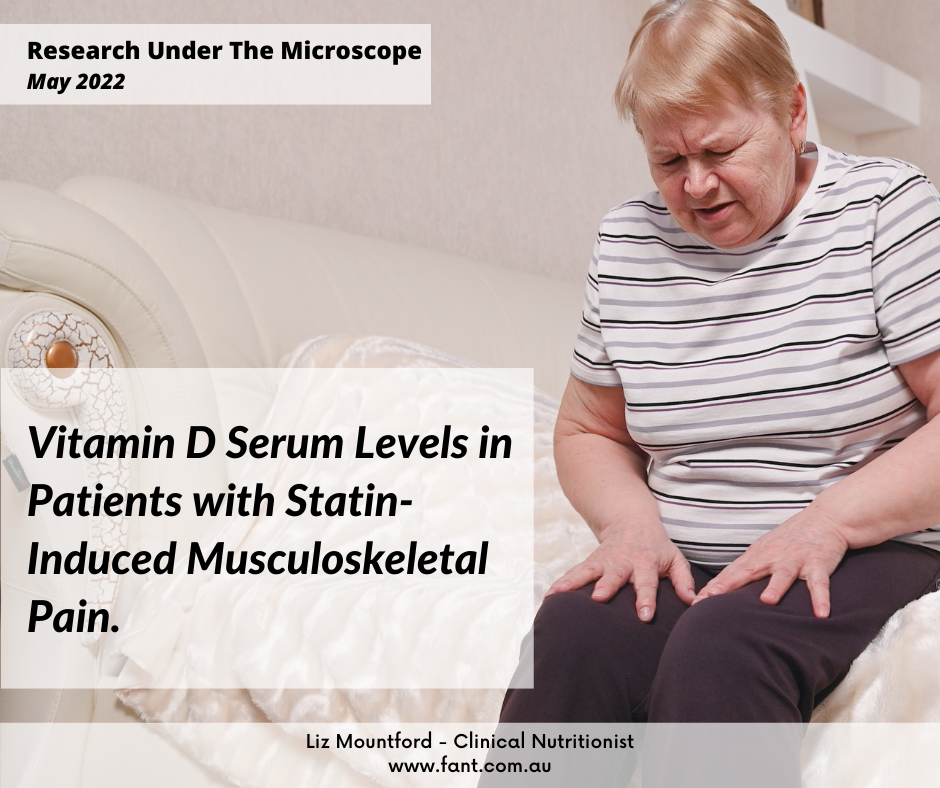Research Under The Microscope Series
The aim of “Research Under The Microscope” series is to translate research papers that are quite often technically complicated, extremely lengthy and contain large amounts of data into simple everyday language making it quicker and easier to understand the research findings.
Vitamin D Serum Levels in Patients with Statin-Induced Musculoskeletal Pain.
What is the problem and what is known so far?
Vitamin D deficiency is very common in Australia. It is estimated that just under 25% of the population having a deficiency. Older Australians have the highest rates of vitamin D deficiency.
Vitamin D is a fat-soluble vitamin. It is found in two major forms being D2 (mostly from plant foods) and D3 (found in animal foods and made by the body from sun on our skin).
Vitamin D is required for vital body functions including musculoskeletal health. If a person has a vitamin D deficiency this can lead to muscle aches & pains.
In Australia, statin medications to lower cholesterol are the most widely prescribed medications. It is estimated that over 40% of people aged 65 years and older are taking a statin. One of the side effects of statins is a range of muscle issues such as weakness, pain, aching, stiffness, tenderness, and cramps. In older adults, statin use is more likely to have side effects including muscle problems.
Cholesterol has a very important role to play in the body. One of cholesterols roles is it is needed by the body to make vitamin D in the presence of sunlight. Although statins are very effective at lowering cholesterol by blocking cholesterol production, this though may have unintended consequences of interfering with the formation of vitamin D.
What is the background to this research?
To investigate the role of vitamin D status in patients that are taking a statin in relationship to muscle issues.
What was studied in this research?
Patients already taking statins. Patients were divided into 2 groups: 1) those that had muscle symptoms and 2) patients that didn’t have muscle symptoms.
How was the research performed?
Blood samples were taken to determine vitamin D status and then categories into vitamin D status classifications.
What did the study researchers find?
A person’s vitamin D status was significantly associated with a risk of statin associated muscle issues. It was found that if a person was suffering from statin associated muscle symptoms, they had low vitamin D levels.
What is the take home message?
- Vitamin D deficiency is common in Australia.
- A vitamin D deficiency is linked to statin associated muscle symptoms (SAMS).
- There are certain groups of people that have a higher risk of experiencing SAMS due to vitamin D deficiency including the elderly and those in Aged Care facilities. Vitamin d deficiency may be due for several reasons including:
- Lack of dietary sources such as fatty fish, liver and eggs.
- Reduced sun exposure. For the elderly and those with dark skin an increase in sun exposure is needed to manufactured vitamin D.
- Gastrointestinal issues resulting in vitamin D not being absorbed from foods effectively.
- Medications.
- Reduction in the bodies ability to manufacture vitamin D.
- A person greater than 70 years of age requires 600 IU (15 micrograms) of vitamin D a day to avoid a deficiency only if a person already has adequate vitamin D levels.
- If a person has low levels of vitamin D then supplementation is going to be necessary.
- 3000 – 5000 IU (75 – 125 micrograms) for at least 12 weeks will assist to replete body stores of vitamin D.
- IU = International Units
- Vitamin D Deficiency Range:
- Mild – 30 to 49 nmol/L
- Moderate -12.5 to 29 nmol/L
- Severe – Lower than 12.5 nmol/L
What You Can Do Now
If you are experiencing muscle aches and pain, it is important that you speak with your doctor.
Before you see your doctor, I encourage you to write down when you noticed the commencement of any muscle issues and ask yourself the following:
Did I do anything differently at the time when I started to experience muscle issues, such as:
-
- Did I have a fall or an accident?
- Did I do any work outside such as gardening?
- Has my sleeping been disturbed?
- Did I get a new mattress, chair or start wearing new shoes?
Did anything change in my diet?
Did I start exercising or do any different forms of exercise?
Did I start any new medications or have an increase in my usual medications?
Did I experience any illness?
If you need assistance, changes to your diet or nutrition to manage a health condition should only be undertaken with advice from a suitably qualified nutritional health professional.
This factsheet is for general information only.
Please contact me to discuss your individual needs.
References:
- Pennisi M, Di Bartolo G, Malaguarnera G, Bella R, Lanza G, Malaguarnera M. Vitamin D Serum Levels in Patients with Statin-Induced Musculoskeletal Pain [Internet]. Disease Markers. 2019 [cited 2019 Apr 1]. Available from: https://www.hindawi.com/journals/dm/2019/3549402/abs/2.
- Ward Natalie C., Watts Gerald F., Eckel Robert H. Statin Toxicity. Circulation Research [Internet]. 2019 Jan 18 [cited 2019 Apr 9];124(2):328–50. Available from: https://www.ahajournals.org/doi/full/10.1161/CIRCRESAHA.118.312782

